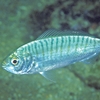General Description
Body relatively deep; first dorsal fin often higher than second dorsal fin, especially in males; second dorsal and anal fins beginning with a spine. Body relatively dark, greyish brown and mottled with reddish spots forming stripes on dorsal fin; a thin brown bar from eye to middle of jaw; midsides with 5-8 dark brown blotches; a thin broken silver stripe just below midsides; a wide v-shaped brown bar before tail; head and anal fin dark in males, fin clear in females; first dorsal fin black anteriorly. To 6 cm.
Biology
A common species on sandy areas. Males signal to others with their high dorsal fin.
Habitat
Sandy areas near seagrass beds and rocky reefs in bays and estuaries, in depths of 0-20 m.
Soft substrates
Reefs
Seagrass meadows
Distribution guide
Southern Australia.
Species Group
Depth
Shore (0-1 m)
Shallow (1-30 m)
Water Column
Max Size
6 cm
Commercial Species
No
Global Dispersal
Native to Australia
Identify
Conservation Status
- DSE Advisory List : Not listed
- EPBC Act 1999 : Not listed
- IUCN Red List : Not listed






